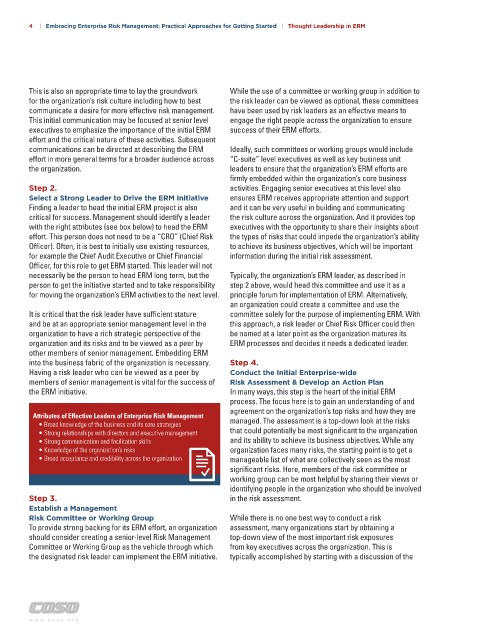Page 673 - COSO Guidance
P. 673
4 | Embracing Enterprise Risk Management: Practical Approaches for Getting Started | Thought Leadership in ERM
This is also an appropriate time to lay the groundwork While the use of a committee or working group in addition to
for the organization’s risk culture including how to best the risk leader can be viewed as optional, these committees
communicate a desire for more effective risk management. have been used by risk leaders as an effective means to
This initial communication may be focused at senior level engage the right people across the organization to ensure
executives to emphasize the importance of the initial ERM success of their ERM efforts.
effort and the critical nature of these activities. Subsequent
communications can be directed at describing the ERM Ideally, such committees or working groups would include
effort in more general terms for a broader audience across “C-suite” level executives as well as key business unit
the organization. leaders to ensure that the organization’s ERM efforts are
firmly embedded within the organization’s core business
Step 2. activities. Engaging senior executives at this level also
Select a Strong Leader to Drive the ERM initiative ensures ERM receives appropriate attention and support
Finding a leader to head the initial ERM project is also and it can be very useful in building and communicating
critical for success. Management should identify a leader the risk culture across the organization. And it provides top
with the right attributes (see box below) to head the ERM executives with the opportunity to share their insights about
effort. This person does not need to be a “CRO” (Chief Risk the types of risks that could impede the organization’s ability
Officer). Often, it is best to initially use existing resources, to achieve its business objectives, which will be important
for example the Chief Audit Executive or Chief Financial information during the initial risk assessment.
Officer, for this role to get ERM started. This leader will not
necessarily be the person to head ERM long term, but the Typically, the organization’s ERM leader, as described in
person to get the initiative started and to take responsibility step 2 above, would head this committee and use it as a
for moving the organization’s ERM activities to the next level. principle forum for implementation of ERM. Alternatively,
an organization could create a committee and use the
It is critical that the risk leader have sufficient stature committee solely for the purpose of implementing ERM. With
and be at an appropriate senior management level in the this approach, a risk leader or Chief Risk Officer could then
organization to have a rich strategic perspective of the be named at a later point as the organization matures its
organization and its risks and to be viewed as a peer by ERM processes and decides it needs a dedicated leader.
other members of senior management. Embedding ERM
into the business fabric of the organization is necessary. Step 4.
Having a risk leader who can be viewed as a peer by Conduct the initial Enterprise-wide
members of senior management is vital for the success of Risk Assessment & Develop an Action Plan
the ERM initiative. In many ways, this step is the heart of the initial ERM
process. The focus here is to gain an understanding of and
agreement on the organization’s top risks and how they are
Attributes of Effective Leaders of Enterprise Risk Management
• Broad knowledge of the business and its core strategies managed. The assessment is a top-down look at the risks
• Strong relationships with directors and executive management that could potentially be most significant to the organization
• Strong communication and facilitation skills and its ability to achieve its business objectives. While any
• Knowledge of the organization’s risks organization faces many risks, the starting point is to get a
• Broad acceptance and credibility across the organization manageable list of what are collectively seen as the most
significant risks. Here, members of the risk committee or
working group can be most helpful by sharing their views or
identifying people in the organization who should be involved
Step 3. in the risk assessment.
Establish a Management
Risk Committee or Working Group While there is no one best way to conduct a risk
To provide strong backing for its ERM effort, an organization assessment, many organizations start by obtaining a
should consider creating a senior-level Risk Management top-down view of the most important risk exposures
Committee or Working Group as the vehicle through which from key executives across the organization. This is
the designated risk leader can implement the ERM initiative. typically accomplished by starting with a discussion of the
w w w . c o s o . o r g

